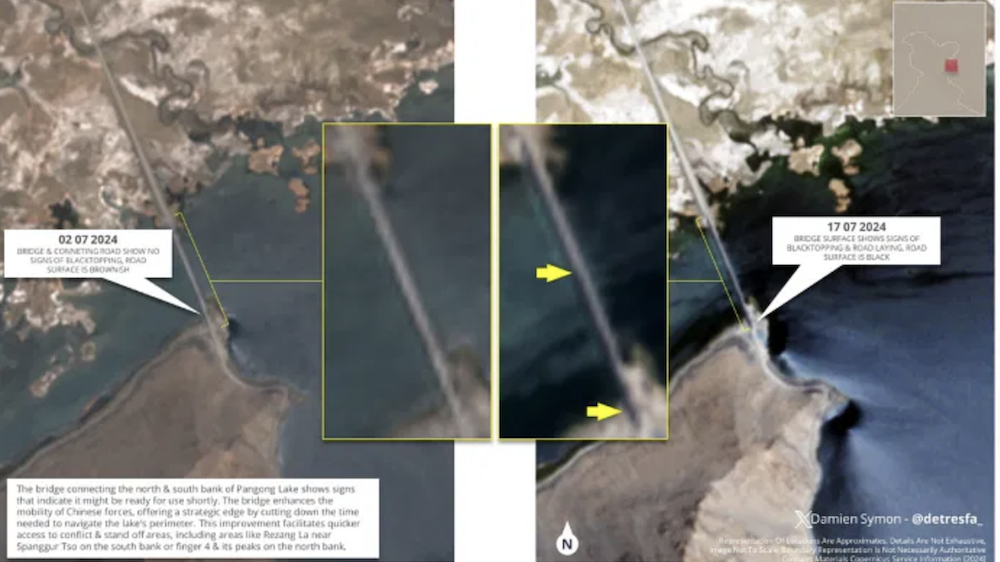Tibet. The Lost Frontier by Claude Arpi
Reviewed by Sreeram Chaulia
 Although the absorption of Tibet into China since 1950 has been copiously discussed from different angles, there is a dearth of understanding about the regional politics surrounding the “roof of the world”. Since time immemorial, Tibet’s fate has been intertwined with that of its two giant neighbors, China and India. French scholar Claude Arpi’s new book teases out the complex workings of this triangle and throws light on how Indian idealism came a cropper against Chinese realpolitik.
Although the absorption of Tibet into China since 1950 has been copiously discussed from different angles, there is a dearth of understanding about the regional politics surrounding the “roof of the world”. Since time immemorial, Tibet’s fate has been intertwined with that of its two giant neighbors, China and India. French scholar Claude Arpi’s new book teases out the complex workings of this triangle and throws light on how Indian idealism came a cropper against Chinese realpolitik.
Arpi begins with a historical distillation about the nature of the triangle: “Tibet and China always had a relation based on force and power, while Tibet and India had more of a cultural relationship based on shared spiritual values.” (p 25) In the Medieval age, Indian and Tibetan Buddhist seers and translators crisscrossed their respective borders in a constant exchange of knowledge and wisdom. Arpi classifies Tibet as “a child of Indian civilization”.
However, the decline and disappearance of Buddhism in India pushed Tibet to find new protectors to preserve the Dharma and this set the stage for priest-patron relationships with Mongol and Chinese emperors. This politico-spiritual system lasted for centuries until Manchu troops invaded Tibet in 1908.
Up until the beginning of the 20th century, Manchu representatives in Lhasa forced Tibet to shut foreigners out from gaining trading benefits. By 1904, though, Chinese suzerainty over Tibet became a “constitutional fiction” and the British penetrated the land of snows with boots on the ground. When the Chinese saw that London was vacillating after its initial foray, they adopted a policy of reintegrating Tibet into the Manchu Empire by brute force. In an effort to “Sinicize” Kham (eastern Tibet), Chinese General Zhao Erfeng razed monasteries and beheaded monks with unprecedented brutality.
The Chinese assault forced the 13th Dalai Lama into political asylum in British India in 1910. Desperate for public legitimacy, the occupying Chinese tried to pit the Panchen Lama against the Dalai Lama, but this only raised the ire of Tibetans. Once Chinese troops were driven out of Tibet, the Dalai Lama returned and formally proclaimed independence in 1913. He saw the need to have a balance in relations with the great powers in the neighborhood and also believed in “using force where force is necessary”. (p 93)
The stubborn obstruction of the Dalai Lama’s modernizing reforms by big orthodox monasteries led to his prophecy in 1932 that “Tibetans shall be slaves of the conquerors”. The opportunity for Tibet to assert its independence and build a strong army was also missed due to infighting between the Khampas and Lhaseans, which softened the state for communist raiders.
Chiang Kai-shek’s Kuomintang considered Tibet a part of China and bequeathed this legacy to the succeeding communists. Chairman Mao Zedong was well aware of the strategic importance of Tibet as a gateway through which the Indian sub-continent could be threatened. His “liberation” of Tibet from 1950 onward was a “demonstration to the world of who the real leader of Asia was” and a humiliation of India as a “paper tiger”. (p 18)
For some time, newly independent India followed the British line of recognizing Tibet as a de facto sovereign state. Even up to the early part of 1949, prime minister Jawaharlal Nehru held that Tibet was a separate entity with a separate government. New Delhi supplied light arms and ammunition to the Tibetan government without informing the Chinese and stated its “readiness to help Lhasa with its security concerns”. (p 134)
But by late 1949, Nehru did a volte-face and accepted the fait accompli that Tibet would be invaded by communist China. The Indian army chief, General Cariappa, said his forces would be unable to engage the Chinese in a full-fledged high-altitude war as he was hard pressed on the Pakistan front. Britain and the United States regretted India’s tendency to “throw up its hands and say nothing could be done [to save Tibet] and retire to its own frontiers”. (p 143) Due to the compulsions of geopolitics, the rest of the world placed the onus on India to act before it was too late.
Nehru sacrificed Tibet on the altar of a chimerical “eternal friendship” with China. A week before the People’s Liberation Army (PLA) marched into Tibet, India’s ambassador in Beijing, K M Panikkar, consciously changed the word “suzerainty” to “sovereignty” to define the status of Tibet vis-a-vis China. Arpi deduces that “perhaps the Chinese received indirect [or direct] assurances from Panikkar that India would not intervene”. (p 166)
When the Tibetan parliament decided to appeal to the United Nations (UN) against Chinese aggression, India refused to sponsor it for fear of “upsetting the Chinese”. (p 176) Nehru was not keen on criticizing China regarding Tibet, in the hope that he might “play a more helpful role in mediating between communist and Western powers” over the Korean War. He worked to defer consideration of the immediate concern of Tibet at the UN in order to obtain a ceasefire in distant Korea. India, which had a direct stake in Tibet’s future, acted unclearly about its own national interests at a momentous juncture in its history.
Indian deputy prime minister Sardar Patel bemoaned Nehru’s “lack of firmness and unnecessarily apologetic” tone towards China on Tibet. He warned of the dire threat posed by “the disappearance of Tibet and the expansion of China almost up to our gates”. (p 192) Parliamentarians urged New Delhi to strengthen India’s borders in view of Chinese maps incorporating Assam and Ladakh. But their prescient words fell on deaf ears. Nehru was intent on appeasing China and winning a friendship at any cost on the grounds that “the future of Asia depended on it”. (p 203) Ironically, Arpi notes, “By abandoning Tibetans, he [Nehru] could no longer claim to be the hero of the trampled and the downtrodden.” (p 229)
G S Bajpai, then head of India’s Foreign Ministry, said ambassador Panikkar had “allowed himself to be influenced more by the Chinese point of view, Chinese claims, Chinese maps and regards for Chinese susceptibilities than by India’s interests”. Mao and his premier, Chou Enlai, exploited Nehru and Panikkar’s anti-imperialist instincts to China’s advantage. To Arpi, “The lack of courage and self-confidence of Indian leaders, demonstrated by their need to please the Chinese at any price, cost India her chance to be a leader of the so-called Third World.” (p 211)
With all doors of assistance – Indian or Western – closed, Tibetans had little choice but to consent to be a province of the “Great Chinese Motherland”. India was reportedly “somewhat shocked” at the extent of Tibetan capitulation to China in the 17-point agreement of 1951, but was thereafter “inclined to adopt an attitude of philosophic acquiescence”. (p 243)
The Indian representative in Lhasa was redesignated a consul-general under the Indian Embassy in Beijing. Indian diplomats bent backward to accommodate Chinese demands and conceded rights in Tibet that were inherited from the Simla Convention of 1914. Panikkar recommended that India should dismantle its “colonial rights” in Tibet and offer them to China as a necessary gesture of goodwill. India even began supplying rice to the PLA forces in Tibet from 1952 to help Beijing consolidate its conquest. True autonomy for Tibet, which would have assured security for India’s borders, was jettisoned.
When a farsighted Indian Foreign Service officer wrote ominously about Chinese military designs on the northeast frontier of India, Nehru dismissed it as “not quite an objective or balanced view as it was colored very much by certain conceptions”. (p 263) At the 1953-54 Beijing conference, Indian diplomats obsessed with “broader perspectives” and “larger issues”, such as creation of a neutral “third pole” in world affairs, while the Chinese side came with the hardnosed goal of formalizing its occupation and ownership of Tibet.
The Five Principles (Panchsheel) Agreement of 1954 gave Beijing what it wanted and saw New Delhi surrender its “old advantages” in Tibet. India could not even get a confirmation of the McMahon Line as the undisputed border with China. From June 1954, with no traditional Tibetan buffer left, Chinese military incursions into Indian territories commenced. Indian traders and pilgrims were harassed in Tibet by the new “revolutionary” authorities. About 1955, China embarked on building a highway through Indian territory in the Aksai Chin area to connect Tibet with Xinjiang.
Mesmerized by Chou’s guile, Nehru justified these Chinese actions without taking retaliatory measures or issuing timely protests. In 1957, Chou told Nehru that though the McMahon Line was “unfair to us, we feel that there is no better way than to recognize it”. (p 301) But the Chinese leadership had already decided to “teach India a lesson” for encouraging and ultimately offering asylum to the 14th Dalai Lama and his people. The PLA’s onslaught on India across the McMahon Line in 1962 pricked the bubble of “Asian brotherhood”.
Nehru’s successor, Lal Bahadur Shastri, took a tougher stand and voted in favor of the 1965 UN resolution for self-determination in Tibet. In 1967, the Indian army repulsed Chinese troops trying to intrude into Sikkim, in the eastern Himalayas. The incident “made Beijing think twice” and ushered in frosty Sino-Indian relations for decades. In 1986, the PLA was thwarted from nibbling at Indian territory in Arunachal Pradesh in the Sumdorong Chu incident. This again gave the Beijing leadership pause for thought since it “had earlier always considered India to be a weak nation”. (p 307) Yet, as of 2008, India’s defense infrastructure along the Chinese border remains below par.
The Sino-Indian border row is unsolved to this day, even as Tibetan autonomy has vanished. Arpi mocks recent optimism about China among “Panikkar’s children” in the corridors of Indian foreign policymaking. He nails down the main problem as follows: “While the Chinese remain pragmatic, most of the Indian leaders are sentimental.” (p 313)
The moral from history for India is that atmospherics are superficial facades behind which China is an unpredictable and wily bargainer. With the destiny of Tibet already sealed as a graveyard of Indian idealism, New Delhi is now left to strive for its own territorial integrity against a surging Beijing. A bilateral settlement that could not be reached in 1954 has much less chance of materializing today when China’s power is on the ascendant.
Tibet. The Lost Frontier by Claude Arpi. Lancer Publishers, Olympia Fields (October 2008). ISBN: 0-9815378-4-7. Price: US$27, 338 pages.









